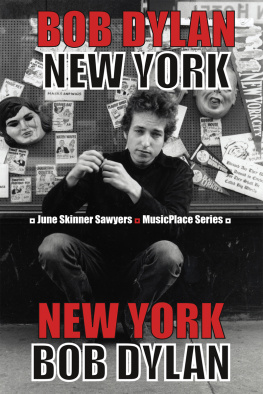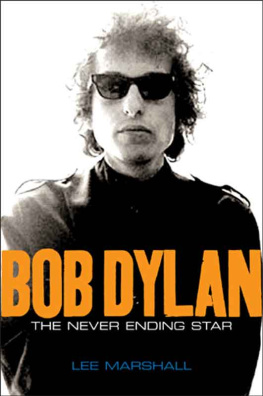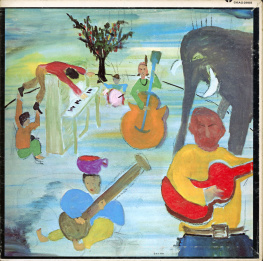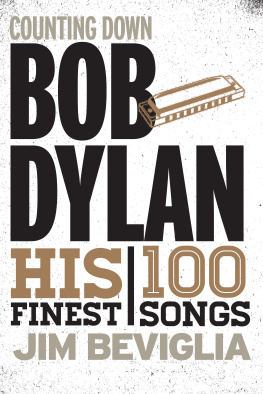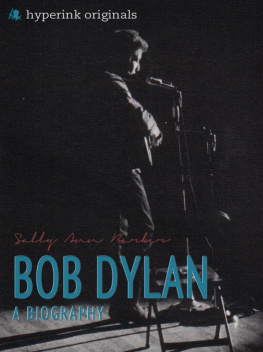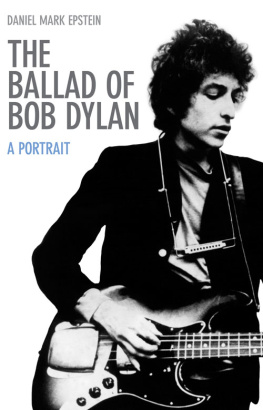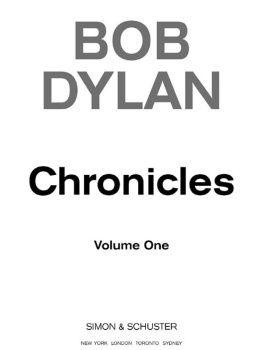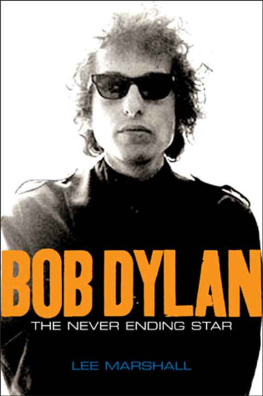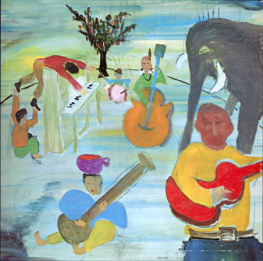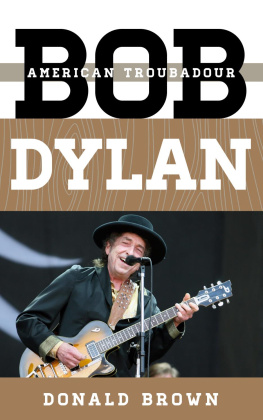
Roaring Forties Press
1053 Santa Fe Avenue
Berkeley, California 94706
All rights reserved. First published in 2011.
Copyright 2011 June Skinner Sawyers
Printed in the United States of America
Library of Congress Cataloging-in-Publication Data
Sawyers, June Skinner, 1957
Bob Dylan : New York / June Skinner Sawyers.
p. cm. -- (MusicPlace series)
Includes bibliographical references.
ISBN 978-0-9843165-9-5 (pbk. : alk. paper) -- ISBN 978-0-9846254-3-7 (kindle) -- ISBN 978-0-9846254-4-4 (epub) -- ISBN 978-0-9846254-5-1 (pdf) 1. Dylan, Bob, 1941---Homes and haunts--New York (State)--New York. 2. Musicians--New York (State)--New York. I. Title.
ML420.D98S26 2011
782.42164092--dc22
2011004297
contents
acknowledgments
T his book is built on the scholarship of many others. Especially helpful were the works of Greil Marcus, Sean Wilentz, Michael Gray, and Christopher Ricks, as well as Dylan biographies by Howard Sounes, Robert Shelton, and Bob Spitz, among others. Memoirs describing New York in the 1950s, 1960s, and 1970s were also helpful. Most gratifying of all was the time I spent walking up and down the streets of Manhattan, from Greenwich Village to the Upper West Side.
I would like to take this opportunity to thank several people for their invaluable assistance and input, including Theresa Albini, Colleen Sheehy, Marco Matonich, Robert Dunn, Mitch Blank, Tiffany Collanino of the Woody Guthrie Archives, Ronald Cohen, and Jonathan Smele. Special recognition goes to Anthony DeCurtis, Villager and Dylan scholar, for his insights.
Thank you to Deirdre Greene and Nigel Quinney, my publishers, for taking on this project and bringing it to fruition.
greenwich village

upper west side, upper east side, and midtown
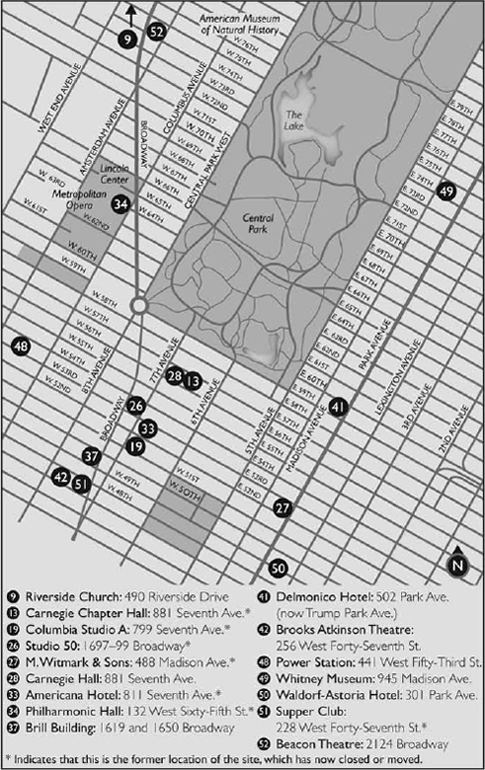
midtown, Chelsea, and gramercy park



A youthful Bob Dylan performs at Gerdes Folk City in 1961.
introduction
bob dylans new york dream
I n December 1960, Bob Dylan dropped out of college. On a snowy winter morning the next month, he left the Twin Cities with a few pieces of clothing in a suitcase, a guitar, a harmonica rack, and a few bucks in his pocket, heading east to find Woody Guthrie. Dylan played his first gig the very day he arrived in New York. By the end of the year, he had performed at one of the premier folk clubs in the United States.
This book focuses on the transformation of a Woody Guthrie wanna-be into a folk and rock music icon. It emphasizes Dylans first half-dozen years in New York, when the cityand Greenwich Village in particularhad its most profound influence on him. It then follows his New York odyssey through the 1960s and into the first half of the 1970s, touching on his subsequent relationship with the city as he dropped by intermittently over the ensuing decades.
Robert Zimmerman may have been born in the North Country cold-water port of Duluth and raised in land-locked Hibbing on the Mesabi Iron Range, but he was reborn as Bob Dylan in New York. As Dylan writes in Chronicles, the first volume of his memoirs, New York City was the magnetthe force that draws objects to it.

On a cold day in Greenwich Village, the young Bob Dylan looks up at his West Fourth Street apartment during the cover shoot for his Freewheelin album.
chapter 1
looking for woody
Hey, hey, Woody Guthrie, I wrote you a song
Bob Dylan, Song to Woody
B ob Dylan arrived in New York City in late January 1961, during one of the coldest winters on record. The temperature was 14 Fahrenheit; nine inches of snow lay on the ground. A North Country boy, he felt right at home.
Dylan had traveled from Minnesota in a four-door 1957 Impala sedan, dozing much of the way in the backseat. He came to New York, the biting wind hitting him smack in the face, to meet his hero, Woody Guthrie. He knew no one in the city, but he wasted no time getting a gig once he arrived. Like many a musician before and since, he made his way to Greenwich Village, Americas historic bohemia. In fact, Dylan performed at the renowned Village coffeehouse the Caf Wha? the day he set foot in the city. I was ready for New York, he commented years later.
Dylan boasted that when he left Minnesota, he left the past behind. I didnt think I had a past, he said. Of course, that was not quite true, but it made for good copy. Hungry for experience, he reinvented himself as the reincarnation of his spiritual father, Woody Guthrie, complete with guitar, harmonica, and faux hayseed accent.
Dylan soon mixed his newfound drawl with the hipster attitude of the Beats, infusing his language with an element of urban sophistication. Still, Guthrie remained his musical mentor. The first significant song he wrote, Song to Woody, was composed in five minutes at the Mills Tavern on Bleecker Street on February 14, a few weeks after he arrived in New York.
cheap and safe
New York in the early 1960s was perched on the precipice of change, moving from one erathe supposed innocence of the Eisenhower yearsto anotherthe dynamic but short-lived excitement of the Kennedy years. Indeed, the relatively short span between Eisenhowers election in 1952 and the arrival of the Beatles in America in 1964 ushered in a decade or so of social change that shook American society to its very core on many levels: politically, socially, and economically. From peaceful civil rights demonstrations in the streets to racially tinged riots, the 1960s started with a gentle whimper and ended with an explosive bang.
People made their way to New York from all over the country, and they still do, of course. But New York was different then in ways that are almost unimaginable today. For one thing, it was both cheap and safe. New York prides itself nowadays as being the safest big city in the United Statescrime rates have plummeted over the last decadebut the cost of living, especially in Manhattan, is very steep. So steep in fact that if Dylan were arriving in New York today he wouldnt be able to afford to live in Manhattan.
Not only the rents were cheap. Everything was cheapit cost a nickel to ride the Staten Island ferry. Even when Patti Smith came to town a few years later, in 1967, as a twenty-year-old exile from New Jersey, she could order a cup of coffee, a slice of toast and jam, and one egg for as little as fifty cents. The city was safe enough for her to sleep on a park bench in Central Park without fear of being harassed.
Cultural attitudes in the early 1960s were different too, and in rather unexpected ways, such as the citys unspoken dress code. With the exception of Greenwich Village, most Manhattanites conformed to a strict and conventional dress code. Women and girls were expected to dress properlyno pants and certainly no blue jeanswhether going to the office or going about their business on an ordinary day; businessmen always wore suits and ties to work. People in the outer boroughs dressed up when they went to Manhattan.
Next page
